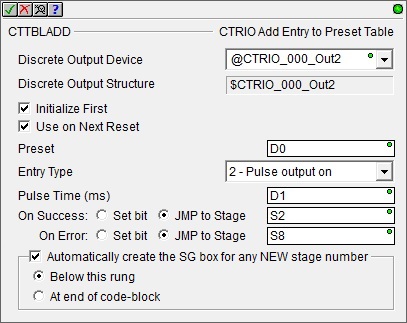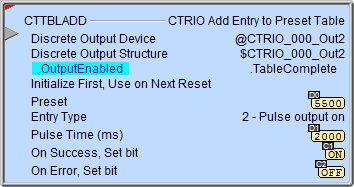DMD0531
CTTBLADD - CTRIO Add Entry to Preset Table
The CTRIO Add Entry to Preset Table (CTTBLADD) instruction is used to add an entry to the table that is currently loaded for the specified CTRIO Discrete Output or create one in CTRIO memory for immediate use. The CTTBLADD instruction can be used with both the CTRIO and CTRIO2 module. This instruction implements three different CTRIO functions: Add Table Entry, Initialize Table, and Initialize Table on Reset.
Changes made to CTRIO Preset tables using this instruction do not change any of the Preset tables that were configured in the Module Configuration for the CTRIO. They are temporary and are lost on a power-cycle of the CTRIO or if some other table is loaded in their place. The changes made by this instruction cannot be viewed in the Module Configuration.

Parameters:
Note: Use the F9 key or click the 'three dot box' at the right edge of the parameter field to open the Default Element Selection Tool (the Element Picker or the Element Browser) or use the Down-Arrow key (Auto-Complete) on any parameter field to see a complete list of the memory locations that are valid for that parameter of the instruction.
Discrete Output Device - selects which preconfigured CTRIO Discrete Output device to use. Before this instruction can select a Discrete Output device, a CTRIO Device must be configured with at least one of its output channels setup for Discrete output mode.
no devices available - indicates that there are no CTRIO Discrete Output devices that have been configured that can perform this instruction.
create module - will open the Create New Module Configuration dialog where a CTRIO Module can be created and then a CTRIO Discrete Output device can then be configured.
Discrete Output Structure - displays the name of the Discrete Output structure that will be used by this instruction. This structure was created when the CTRIO module configuration was read during the Module Configuration phase.
Initialize First - optionally clear any entries in the currently loaded table before adding the preset specified in this instruction. This selection implements the CTRIO function Initialize Table.
Use on Next Reset - (only valid with Initialize First) - will perform the initialization and adding of the Preset when the count value is reset. This selection implements the CTRIO function Initialize Table on Reset.
Preset
- specifies the count at which the desired action will take place. This
can be any positive or negative constant value, or any readable numeric
location.
Entry Type - specifies which of the following actions to perform at the specified Preset:
-
1 - Set Output OFF
Pulse Time - (only valid Entry Type is 2 or 3) - specifies the duration of the pulse, in milliseconds, when the Entry Type is set to 2 (Pulse Output ON) or 3 (Pulse Output OFF). This can be any constant value from 0 to 65535, or any readable numeric location.
The On Success and On Error parameters specify what action to perform when this instruction completes. You do not have to use the same type of selection for both On Success and On Error.
If the Set Bit selection is used for either On Success or On Error, the specified BIT location will be SET OFF when the instruction is first enabled and will remain OFF until the instruction completes. Once complete, the appropriate Success or Error bit location ON. The specified Bit location is enabled with a SET (Latch) operation meaning that it will remain ON even if the input logic for the instruction goes OFF.
If the JMP to Stage selection is used for either On Success or On Error the target Stage must be in the same Program code-block as this instruction, you cannot specify a target Stage that exists in a different Program code-block. When the operation finishes, the target Stage will be enabled the same way as a standalone Jump to Stage (JMP) instruction would do it. The JMP to Stage option will only be available if this instruction is placed in a Program code-block.
On Success selects which of the following actions to perform if the operation is successful:
- Enable SET Bit then specify any writable bit location.
- Enable JMP to Stage then specify any
Stage number from S0 to S127 in the current Program code-block.
On Error selects which of
the following actions to perform if the operation is unsuccessful:
- Enable SET Bit then specify writable bit location.
- Enable JMP to Stage then specify any Stage number from S0 to S127 in the current Program code-block.
If either the On Success or On Error selections are set to JMP to Stage, Automatically create the SG box for any NEW stage number will be enabled which will automatically create any target stage that does not already exist.
- Below this rung will create the new target stage on a new rung following this instruction.
- At end of code-block will create the new target stage as the last rung of this Program.
Note: any time the On Error condition occurs, the CTRIO generates an Error Code that can be read in the <Module Name>.ErrorCode (Module Name is the name assigned to the CTRIO in the Module Configuration). The List of Error Code values (in decimal) follows:
Status Display:

The status display of the instruction
shows Values:
Preset, and Pulse
Time (ms), and Highlight:
.OutputEnabled, and
.TableComplete bits.
The red triangle in the upper left corner of the status display indicates this is a Fully Asynchronous instruction.
The gray triangle at the right end of the input leg indicates the input is edge-triggered, meaning this instruction will execute each time the input logic transitions from OFF to ON.
CTRIO Structure Field Care-Abouts:
The following is a list of the"dot" fields of the CTRIO structure that are programmatically used with the CTRIO Add Entry to Preset Table (CTTBLADD) instruction. To see a complete listing of all CTRIO structures and members, go to the Project Browser --> Configuration --> Memory --> I/O --> Specialty.
COLOR KEY
Blue: CTRIO Input
Maroon: CTRIO Output
Black: CTRIO Module
Silver: Not used for this instruction
Note: The red "x" is the digit 0, 1, 2, or 3.
NOTES:
(1)This structure member only available for CTRIO2 (not CTRIO). For CTRIO this remains zero.
See Also:
CTDYNPOS - CTRIO Run Dynamic Position Mode
CTDYNVEL - CTRIO Run Dynamic Velocity Mode
CTPLSADD - CTRIO2 Add Entry to PLS
CTPLSEDT - CTRIO2 Edit PLS Entry
CTREGWR - CTRIO Write Register
CTRUNPOS - CTRIO Run Position Mode
CTRUNVEL - CTRIO Run Velocity Mode
CTTBLADD - CTRIO Add Entry to Preset Table
CTTBLEDT - CTRIO Edit Preset Table Entry
Example 1 of 2:
Description of a Typical CTRIO Add Entry to Preset Table (CTTBLADD) Stage Diagram:
This is a stage diagram of a simple sequence control that would create a Discrete Table for a CTRIO output and add 7 entries to it.

Initially the SetON stage creates the Discrete Table and adds the first entry to set the output ON at a certain preset value.
SetOFF adds 2nd entry to set the output OFF at a certain preset.
P-ON (PulseON) adds 3rd entry to pulse the output ON for a time period at a certain preset.
Tog1 (Toggle1) adds 4th entry to toggle the output from OFF to ON at a certain preset.
P-OFF (PulseOFF) adds 5th entry to pulse the output OFF for a time period at a certain preset.
Tog2 (Toggle2) adds 6th entry to toggle the output from ON to OFF at a certain preset.
RstCnt (ResetCount) adds 7th and final entry to reset the count at a certain preset.
EnOut (EnableOutput) enables the output to work and exits.
Description of a Typical CTRIO Add Entry to Preset Table (CTTBLADD) Stage Ladder:
This is the ladder equivalent of the above stage diagram of a simple sequence control that would create a Discrete Table for a CTRIO output and add 7 entries to it.
This example presupposes the existence of the following System Configuration for the CTRIO (PLC --> System Configuration --> Module Configuration(s) --> CTRIO_000 -->):
-
Configure I/O -->
-
A quadrature encoder is wired to CTRIO's Channel 1 Input A & B.
-
A discrete device that utilizes the CTRIO's Output is wired to CTRIO's Output 2.

Initially the SetON stage creates the Discrete Table and adds the first entry to set the output ON at a the preset value of 2000 (notice the Initialize First setting). Also the output is disabled ($CTRIO_000_Out2.EnableOutput = OFF) while this table is created in CTRIO memory. If there is an error the transition is made to the ErrorStage stage where logic should exist (not shown here) to handle the error. If successful transition is made to the next stage.
SetOFF adds 2nd entry to set the output OFF at the preset value of 4000.
PulseON adds 3rd entry to pulse the output ON for 2 seconds at the preset value of 6000.
Toggle1 adds 4th entry to toggle the output from OFF to ON at the preset value of 8000.
PulseOFF adds 5th entry to pulse the output OFF for 1 second at the preset value of 10,000.
Toggle2 adds 6th entry to toggle the output from ON to OFF at the preset value of 12,000.
ResetCount adds 7th and final entry to reset the count at the preset value of 14,000.
EnableOut enables the output ($CTRIO_000_Out2.EnableOutput = ON) to work. When the feedback bit ($CTRIO_000_Out2.OutputEnabled) shows it is enabled, the program code block is exited.
The ErrorStage is executed if any of the CTTBLADD instructions get an error.
Example 2 of 2:

